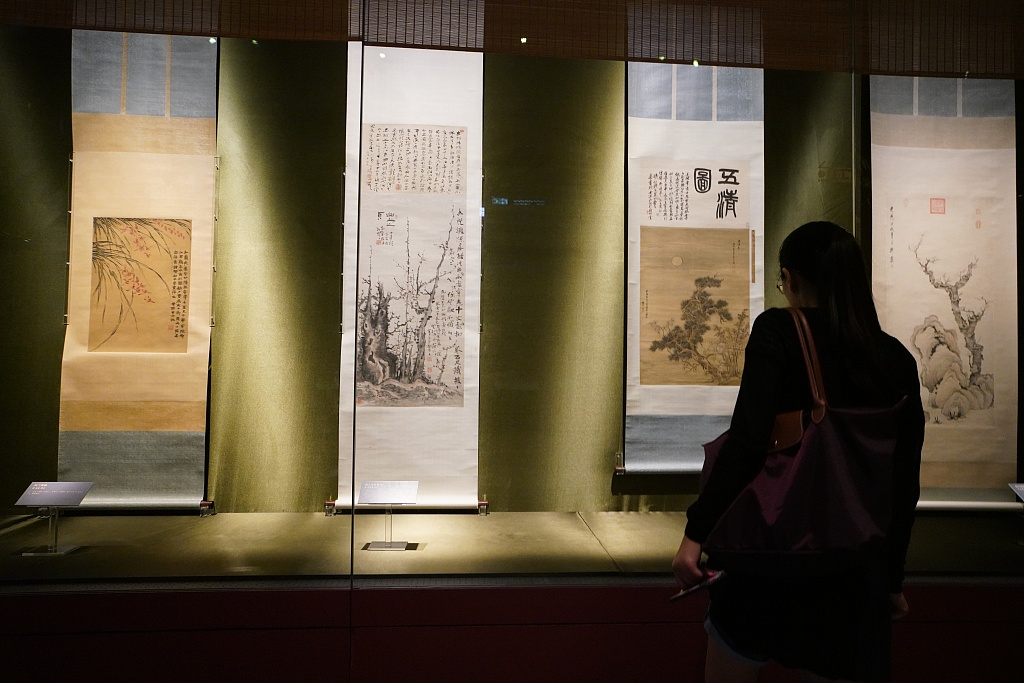
An exhibition titled "Seasons of Beauty: A Special Exhibition of Floral Themed Artifacts" opened on September 2 at the Palace Museum in Beijing. Through 307 pieces of artifacts themed or decorated with flora, visitors can fully explore the floral culture of ancient China.

A head decoration on exhibition at the Palace Museum in Beijing, September 3. /VCG Photo
The exhibition is divided into three sections. "Seasonal Sketches," featuring paintings by ancient professional artists, shows typical plants of the four seasons. "Refined Leisure" showcases ink brushwork about plants favored in traditional Chinese values. "Emotive Significance" elaborates on the deep meanings of the plants on femininity, auspiciousness, religion and more.
Among the 307 artifacts on show, only one is on loan from the Tianjin Museum, while others are all from the Palace Museum. Most of them are paintings, but the art forms also include porcelain vessels, lacquerware, embroidery, folding screens and books. Many of them are on public display for the first time.

Paintings on flora on display at the Palace Museum, September 3, 2019. /VCG Photo
In Chinese, "huamu" from the theme of this exhibition refers to flowers and trees. It's a term that frequently used in a historical context, while modern people use "huahui" instead to describe decorative flowers and plants. Through the word "huamu," the exhibition tries to reflect how ancient people looked at plants and the relationship between man and nature in ancient times.
The exhibition systematically showcases the beauty of art around the theme of flora and the cultural meanings behind the artworks. This is also the first large-scale comprehensive exhibition with relics about plants in the world.
Specifically, the exhibition contains a good amount of pieces from the Song and Yuan dynasties, which have great artistic values. A painting called "Hundred-Flower Picture" (Bai Hua Tu) by a nameless artist is one of them. With a length nearly 17 meters, it covers about 60 kinds of flowers of the four seasons. Although the content is rich, the scenes transit naturally with the decoration of dragonflies, bees, frogs and other animals. The delicate painting breaks the restrictions of time and space in traditional flora-themed artworks and has a profound influence on later ink artists like Qian Xuan and Wang Yuan in Yuan Dynasty.

Ink paintings at the exhibition, September 3, 2019. /VCG Photo
According to Wang Xudong, who just assumed the position as the director of Palace Museum after the retirement of Shan Jixiang this April, the flora-themed exhibition this time is also to celebrate the 70th anniversary of the founding of the People’s Republic of China. It bears the wish for the country to boom and prosper.
To better document the exhibition, a book with the same title is published (two volumes in total). It not only includes all the artifacts displayed, but also other cultural relics which are dormant or can’t be exhibited due to space limitations. Some academic papers on Chinese ancient paintings of flora are also included.

Lacquerware inscribed with plant patterns at the exhibition, September 3, 2019. /VCG Photo
The show is co-curated with the Shenyang Palace Museum in Shenyang, Liaoning Province. From September 2, an exhibition with the same theme also opened at the Shenyang Palace Museum, putting 70 pieces (sets) of local relics on show, including porcelain, jade wares, lacquerwares, embroidery and bonsai.
The exhibition ends on October 31.

Copyright © 2018 CGTN. Beijing ICP prepared NO.16065310-3
Copyright © 2018 CGTN. Beijing ICP prepared NO.16065310-3